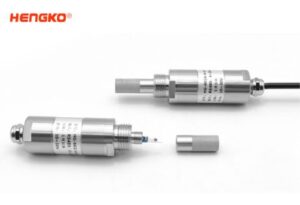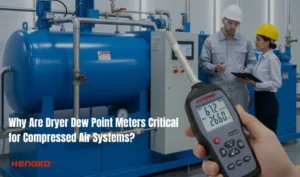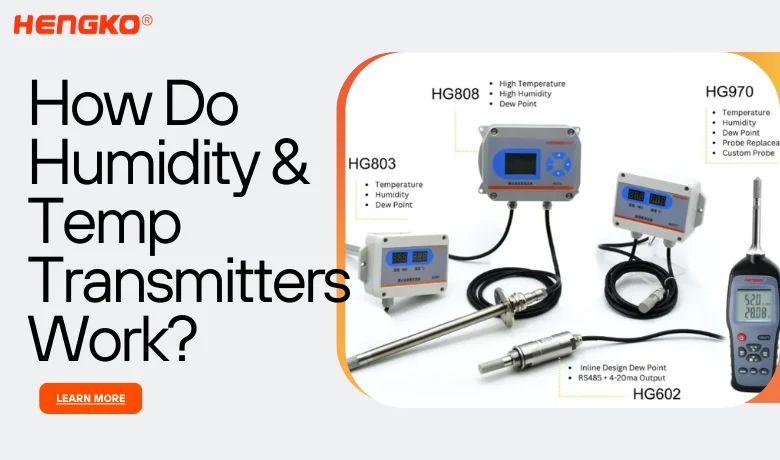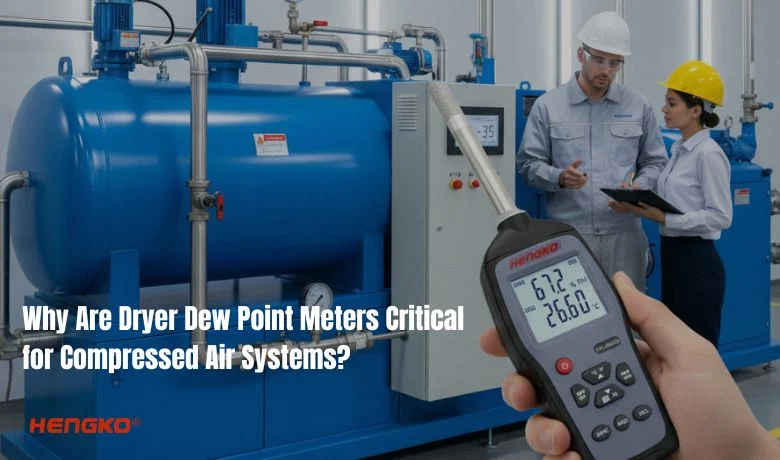
Come funzionano i trasmettitori di umidità e temperatura?
In short, Humidity and temperature transmitters measure and send environmental data to control systems. They
Tiny Drops, Big Impact: How Dew Point Transmitters Shape Your World
Casa " Trasmettitore di punto di rugiada
Discover the key factors to consider when selecting the optimal dew point temperature and humidity transmitter for reliable, accurate environmental monitoring across various applications from HENGKO.
Check Dew Point Sensor / Transmitter Selection Guide First
| Modello | Per condizione di applicazione | Caratteristiche principali |
| 1. Inline Dew Point Transmitter (Small HG602 Series ) | ||
Standard Precision Misura del punto di rugiada Intervallo del punto di rugiada: -60 … +60°C | - ±2 °C (±3.6℉)Td Accuracy (Dew Point) | |
| HG602-G (new) | Acidic / Corrosive Gas Environment Dew Point Monitoring Intervallo del punto di rugiada: -60 … +20°C | – ±3 °C (±5.4℉)Td Accuracy (Dew Point) – 316L stainless steel + anti-corrosion coating – Oil, salt spray & acid resistant (IP65 housing) – Suitable for HF, Cl₂, NH₃ and organic vapor applications |
Cold and Dry Environment Misura del punto di rugiada Intervallo del punto di rugiada: -30 … +50°C | - ±1℃ (±3.6℉) Td Accuracy (Dew Point) | |
| 2. Box Type Dew Point Transmitter ( HG808 Series ) | ||
| HG808-D | Normal Temperature Environment Dew Point Measurement Intervallo del punto di rugiada: -60 … +90°C | – Dew Point Accuracy: ±2℃ (±5.4℉) Td |
Chemical / Acidic / Solvent Gas Monitoring Intervallo del punto di rugiada: -60 … +20°C | – Dew Point Accuracy: ±3℃ (±5.4℉) Td | |
| HG808-A | Ultra High Temperature Moisture-Sensitive Applications + Dew Point Measurement Intervallo del punto di rugiada: -20 … +100°C | – Dew Point Accuracy: ±3℃ (±5.4℉) Td – Operates +80 °C to +180 °C (200 °C Short-lived) – 316L stainless steel sensor housing – Fast response & long-term stability under heat stress |
HG602 Series
The Inline Dew Point Sensor is an innovative tool designed to integrate seamlessly into various industrial and commercial systems.
HG808 Series
HENGKO offers a wide range of temperature and humidity dew point sensors for many application.
HENGKO offre un'ampia gamma di sensori di temperatura e umidità industriali adatti a varie esigenze di monitoraggio, che vanno da sonde in acciaio inox a trasmettitori di punto di rugiada and as following 6 kinds of temperature and humidity monitor devices solution. Our focus is on providing accurate, reliable, and long-lasting sensors, making them perfect for a diverse array of applications.
Serie HG970
The Handheld Dew Point Meter is a compact, portable device designed for precise and convenient measurement of humidity in various environments.
HENGKO è leader mondiale nelle soluzioni di sensori industriali, con una reputazione di design unico e prestazioni eccellenti. I nostri trasmettitori e sensori di temperatura e umidità sono utilizzati in un'ampia gamma di settori, tra cui quello alimentare e delle bevande, farmaceutico, manifatturiero e del monitoraggio ambientale.
È possibile personalizzare completamente un prodotto unico di sensore di punto di rugiada basato sulla nostra serie di trasmettitori di punto di rugiada brevettati e autoprogettati.
Otterrete un prezzo molto più basso e competitivo grazie al nostro controllo estremamente conveniente.
Con i nostri prodotti in continuo aggiornamento potrete sempre soddisfare le esigenze del mercato in continua evoluzione.
Avrete un forte supporto di marketing per aiutarvi a vendere i prodotti con successo, il materiale di supporto include: immagini dei prodotti ad alta risoluzione, video ad effetto 3d e molto altro ancora.










Sensore del punto di rugiada per il monitoraggio del sistema di aria compressa: garantisce un controllo ottimale dell'umidità e della qualità dell'aria per la macchina a compressione d'aria.
HENGKO è un produttore leader di trasmettitori professionali del punto di rugiada, trasmettitori di temperatura e umidità e misuratori portatili del punto di rugiada. Offriamo un'ampia gamma di soluzioni di monitoraggio della temperatura e dell'umidità per soddisfare le vostre esigenze specifiche.
I nostri prodotti sono progettati per garantire precisione e affidabilità, assicurando prestazioni ottimali in varie applicazioni. Che abbiate bisogno di un sensore del punto di rugiada di alta qualità o di un robusto trasmettitore di umidità, HENGKO ha l'esperienza e i prodotti per supportare il vostro progetto.
Contattateci oggi stesso per discutere le vostre esigenze e scoprire le soluzioni migliori per le vostre necessità di monitoraggio.






The dew point is the temperature to which the air must be cooled to become saturated with water vapor. In other words, it is the temperature at which the air can no longer hold any more water vapor in the form of gas. If the air is cooled further, the excess water vapor will condense into liquid water, forming dew.
The dew point is an important meteorological parameter because it is a measure of the amount of moisture in the air. The higher the dew point, the more moisture the air contains. This can make the air feel muggy or uncomfortable, especially on a hot day.
The dew point is also used to forecast the formation of fog and dew. If the dew point is close to the air temperature, then fog or dew is likely to form. This is because the air is close to becoming saturated, and any further cooling will cause the water vapor to condense.
Here is a table of general comfort levels using dew point:
| Dew Point (°F) | Comfort Level |
|---|---|
| Below 50 | Comfortable |
| 50-60 | Somewhat muggy |
| 60-65 | Muggy |
| 65-70 | Very muggy |
| Above 70 | Oppressive |
As you can see, dew point is a good indicator of how comfortable the air will feel. If you are planning to be outdoors, it is a good idea to check the dew point forecast before you go.
Here are some of the main features of dew point transmitters:

In addition to these main features, dew point transmitters may also offer a variety of other features, such as:
Dew point transmitters are a valuable tool for measuring and monitoring moisture content in a variety of applications. They are accurate, reliable, and versatile, and they can be used to improve the quality of products, protect equipment, and optimize industrial processes.
There are three main types of dew point transmitters: chilled mirror, polymer, and metal oxide.
Specchio freddo
Chilled mirror dew point transmitters are the most accurate type of dew point transmitter. They work by cooling a mirror until water vapor condenses on its surface. The temperature of the mirror is then measured, and this temperature is the dew point. Chilled mirror dew point transmitters are typically used in applications where high accuracy is required, such as in the pharmaceutical and semiconductor industries.
Polimero
Polymer dew point transmitters are less accurate than chilled mirror dew point transmitters, but they are also less expensive. They work by measuring the change in electrical resistance of a polymer sensor as moisture content changes. Polymer dew point transmitters are typically used in applications where cost is a major concern, such as in the HVAC industry.
Ossido di metallo
Metal oxide dew point transmitters are similar to polymer dew point transmitters, but they use a different type of sensor. Metal oxide dew point transmitters are typically used in applications where a wide measuring range is required, such as in the food and beverage industry.
Here is a table comparing the three main types of dew point transmitters:
| Caratteristica | Chilled Mirror | Polimero | Metal Oxide |
|---|---|---|---|
| Precisione | Alto | Medium | Medium |
| Costo | Alto | Basso | Medium |
| Measuring Range | Wide | Narrow | Wide |
| Tempo di risposta | Slow | Fast | Medium |
| Manutenzione | Alto | Basso | Medium |
| Applicazioni | Pharmaceutical, Semiconductor | HVAC | Food and Beverage |
The best type of dew point transmitter for a particular application will depend on the specific requirements of the application. In general, chilled mirror dew point transmitters are the best choice for applications where high accuracy is required. Polymer dew point transmitters are a good choice for applications where cost is a major concern. Metal oxide dew point transmitters are a good choice for applications where a wide measuring range is required.
Dew point transmitters are important in a variety of applications, including:
Sistemi HVAC: Dew point transmitters are used in HVAC systems to control humidity levels. Humidity is important for human comfort and health. Too much humidity can make the air feel muggy and uncomfortable, and it can also lead to the growth of mold and mildew. Too little humidity can make the air feel dry and can also lead to respiratory problems.
Controllo dei processi industriali: Dew point transmitters are used in industrial process control to ensure that products are manufactured under the correct humidity conditions. Humidity can affect the quality of many products, such as pharmaceuticals, semiconductors, and food and beverages.
Monitoraggio ambientale: Dew point transmitters are used in environmental monitoring to track changes in moisture content in the atmosphere. This information can be used to forecast weather conditions and to identify potential environmental problems.
Here are some specific examples of how dew point transmitters are used in different industries:
Pharmaceutical industry: Dew point transmitters are used to control humidity levels in clean rooms where pharmaceuticals are manufactured. Humidity levels must be carefully controlled to prevent the degradation of drugs and to ensure that they are manufactured to the highest quality standards.
Semiconductor industry: Dew point transmitters are used to control humidity levels in semiconductor fabrication plants. Humidity levels must be carefully controlled to prevent the contamination of wafers and to ensure that semiconductors are manufactured to the highest quality standards.
Food and beverage industry: Dew point transmitters are used to control humidity levels in food and beverage production facilities. Humidity levels must be carefully controlled to prevent the growth of mold and mildew, to ensure that products have the correct texture, and to extend the shelf life of products.
HVAC industry: Dew point transmitters are used in HVAC systems to control humidity levels in homes, offices, and other buildings. Humidity levels must be carefully controlled to ensure human comfort and health.
Monitoraggio ambientale: Dew point transmitters are used in environmental monitoring stations to track changes in moisture content in the atmosphere. This information can be used to forecast weather conditions and to identify potential environmental problems, such as drought or flooding.
As you can see, dew point transmitters are important in a wide variety of applications. They are essential for ensuring the quality of products, protecting equipment, and optimizing industrial processes.
In addition to the benefits listed above, dew point transmitters can also help to:
Choosing the right dew point transmitter for your compressed air system is crucial for maintaining efficient operation and ensuring the quality of your products. Here’s a comprehensive guide to selecting the most suitable dew point transmitter for your specific needs:
Determine the Required Accuracy: Consider the accuracy requirements of your application. If you need precise dew point measurements, a chilled mirror dew point transmitter is the most accurate option. However, if cost is a primary concern, a polymer or metal oxide dew point transmitter may be sufficient.
Evaluate the Measuring Range: Assess the dew point range you need to measure. Compressed air systems typically operate within a specific dew point range, so ensure the transmitter can cover that range effectively.
Consider Response Time and Maintenance: Response time is essential for detecting changes in dew point quickly. If real-time monitoring is critical, choose a transmitter with a fast response time. Maintenance requirements also vary between types. Chilled mirror transmitters require more maintenance, while polymer and metal oxide transmitters are generally low-maintenance.
Select the Appropriate Output Options: Decide on the output options you need for integration with your system. Common output options include analog (4-20 mA or 0-10 V), digital (RS-485 or Modbus), and alarm relays.
Considerazioni ambientali: Evaluate the environmental conditions where the transmitter will be installed. Choose a transmitter that can withstand the expected temperature, humidity, and vibration levels.
Caratteristiche aggiuntive: Consider additional features that may be beneficial, such as data logging, alarm setpoints, and remote access capabilities. These features can enhance monitoring and control capabilities.
Consult with Experts: If you have complex requirements or need assistance in selecting the most suitable dew point transmitter, consult with experienced professionals in the field. They can provide tailored recommendations based on your specific application and needs.
Here’s a summary table to aid in your selection:
| Caratteristica | Chilled Mirror | Polimero | Metal Oxide |
|---|---|---|---|
| Precisione | Alto | Medium | Medium |
| Costo | Alto | Basso | Medium |
| Measuring Range | Wide | Narrow | Wide |
| Tempo di risposta | Slow | Fast | Medium |
| Manutenzione | Alto | Basso | Medium |
| Applicazioni | Pharmaceutical, Semiconductor | HVAC | Food and Beverage |
| Output Options | Analog, Digital, Alarm Relays | Analog, Digital | Analog, Digital |
| Additional Features | Data Logging, Alarm Setpoints, Remote Access | Limitato | Limitato |
L'uscita 4-20mA è una scelta popolare per i sensori di punto di rugiada perché è un'uscita industriale standard compatibile con un'ampia gamma di sistemi di controllo. È inoltre un'uscita molto affidabile e resistente al rumore, che la rende adatta all'uso in ambienti industriali difficili.
Ecco alcuni dei vantaggi dell'uso di un'uscita 4-20mA per i sensori di punto di rugiada:
Compatibilità: L'uscita 4-20mA è compatibile con un'ampia gamma di sistemi di controllo, tra cui PLC, DCS e sistemi SCADA. In questo modo è facile integrare i sensori del punto di rugiada nei sistemi di controllo esistenti.
Affidabilità: L'uscita 4-20mA è molto affidabile e non è soggetta a interferenze di rumore. Questo è importante per i sensori di punto di rugiada, spesso utilizzati in ambienti industriali difficili.
Precisione: L'uscita 4-20mA può fornire misure accurate del punto di rugiada. Ciò è importante per le applicazioni che richiedono un controllo preciso del punto di rugiada.
Gamma: L'uscita 4-20mA può coprire un'ampia gamma di valori del punto di rugiada. Questo lo rende adatto a una varietà di applicazioni.
Costo: L'uscita 4-20mA è un'uscita relativamente economica da implementare. Ciò la rende un'opzione conveniente per i sensori del punto di rugiada.
Oltre ai vantaggi sopra elencati, l'uscita 4-20mA è anche un'uscita molto versatile. Può essere utilizzata per trasmettere una serie di altri parametri, come temperatura, pressione e portata. Ciò la rende un'uscita preziosa per un'ampia gamma di applicazioni industriali.
Ecco alcuni esempi di applicazioni in cui i sensori di punto di rugiada con uscita 4-20mA sono comunemente utilizzati:
Sistemi ad aria compressa: I sensori del punto di rugiada sono utilizzati nei sistemi di aria compressa per monitorare e controllare il contenuto di umidità dell'aria. Questo è importante per prevenire la corrosione e altri danni alle apparecchiature.
Sistemi HVAC: I sensori del punto di rugiada sono utilizzati nei sistemi HVAC per controllare i livelli di umidità negli edifici. Questo è importante per il comfort e la salute delle persone.
Processi di essiccazione industriale: I sensori del punto di rugiada sono utilizzati nei processi di essiccazione industriale per monitorare e controllare il contenuto di umidità del prodotto da essiccare. Questo è importante per garantire la qualità del prodotto.
Lavorazione di alimenti e bevande: I sensori del punto di rugiada sono utilizzati nella lavorazione di alimenti e bevande per controllare il contenuto di umidità del prodotto in lavorazione. Questo è importante per garantire la sicurezza e la qualità del prodotto.
Monitoraggio ambientale: I sensori del punto di rugiada sono utilizzati nelle stazioni di monitoraggio ambientale per monitorare le variazioni del contenuto di umidità nell'atmosfera. Queste informazioni possono essere utilizzate per prevedere le condizioni meteorologiche e identificare potenziali problemi ambientali.
Come si vede, i sensori di punto di rugiada con uscita 4-20mA sono uno strumento prezioso per un'ampia gamma di applicazioni industriali. Sono affidabili, precisi e versatili e possono essere facilmente integrati nei sistemi di controllo esistenti.
Il prezzo dei trasmettitori di punto di rugiada può variare a seconda del produttore, delle caratteristiche e dell'accuratezza del trasmettitore. In generale, i trasmettitori di punto di rugiada con una maggiore accuratezza e un maggior numero di funzioni costeranno di più di quelli con una minore accuratezza e un minor numero di funzioni.
In base alle mie ricerche, direi che il prezzo dei trasmettitori del punto di rugiada è generalmente equo. Il costo dei componenti e della manodopera necessari per la produzione dei trasmettitori del punto di rugiada è elevato e le aziende che li producono devono recuperare questi costi per rimanere in attività. Inoltre, i trasmettitori di punto di rugiada sono utilizzati in una serie di applicazioni critiche, quindi è importante che siano affidabili e precisi. Il prezzo elevato dei trasmettitori del punto di rugiada riflette il fatto che si tratta di strumenti di alta qualità di cui ci si può fidare per fornire misure accurate.
Ecco alcuni fattori che possono influenzare il prezzo di un trasmettitore del punto di rugiada:
Ecco una tabella della gamma di prezzi dei trasmettitori di punto di rugiada presenti sul mercato:
| Tipo | Fascia di prezzo |
|---|---|
| Specchio freddo | $2,000 – $10,000 |
| Polimero | $500 – $2,000 |
| Ossido di metallo | $500 – $1,500 |
Come si può notare, la gamma di prezzi dei trasmettitori di punto di rugiada può variare a seconda del tipo di trasmettitore. I trasmettitori di punto di rugiada a specchio refrigerato sono i più costosi, ma anche i più precisi. I trasmettitori di punto di rugiada a polimeri e ossidi metallici sono meno costosi, ma anche meno precisi.
Il prezzo dei trasmettitori di punti di rugiada può variare anche in base alle caratteristiche del trasmettitore. Ad esempio, i trasmettitori di punto di rugiada con registrazione dei dati, setpoint di allarme e funzionalità di accesso remoto hanno in genere un costo maggiore rispetto ai trasmettitori di punto di rugiada con meno funzioni.
Se siete alla ricerca di un trasmettitore del punto di rugiada di alta qualità, vi consiglio di acquistarne uno di un marchio noto che abbia una buona reputazione in termini di qualità e affidabilità. Dovete anche considerare le caratteristiche più importanti per voi e la precisione che vi serve. Se non siete sicuri di quale sia il trasmettitore di punto di rugiada più adatto a voi, vi consiglio di consultare un professionista che possa aiutarvi a prendere una decisione informata.
alcune domande sul punto di rugiada, sul trasmettitore e sul sensore che voi e le persone desiderano conoscere
A high dew point means that the air can hold a lot of moisture before it becomes saturated and condensation occurs. In general, a dew point above 60°F (15°C) is considered high. High dew points can make the air feel humid and uncomfortable, especially on a hot day.
Actually there are two main types of dew point transmitters, each one with a different working principle, please check as following:
1. Chilled Mirror Dew Point Transmitters:
2. Polymer/Ceramic Sensor Dew Point Transmitters:
Which type is better?
The choice between a chilled mirror and a polymer/ceramic sensor transmitter depends on your specific needs:
I hope this explanation helps!
Feel free to ask or contact our Team by email if you have any further questions about dew point transmitters.
Dew point and humidity are two different measures of the amount of moisture in the air.
1.Dew point is the temperature to which the air must be cooled to become saturated with water vapor. In other words, it is the temperature at which the air can no longer hold any more water vapor in the form of gas. If the air is cooled further, the excess water vapor will condense into liquid water, forming dew.
2.Humidity, on the other hand, is the amount of water vapor in the air, expressed as a percentage of the maximum amount of water vapor that the air can hold. Relative humidity is the most common measure of humidity, and it is calculated by dividing the actual amount of water vapor in the air by the maximum amount of water vapor that the air can hold at that temperature.
There are a few different ways to calculate dew point temperature. The most common method is to use a hygrometer, which is a device that measures both temperature and humidity. The dew point temperature can then be calculated from the temperature and humidity readings using a special formula.
Another way to calculate dew point temperature is to use a psychrometer, which is a device that consists of two thermometers, one with a wet bulb and one with a dry bulb. The dew point temperature can then be calculated from the difference between the wet bulb and dry bulb temperatures using a special table or formula.
No, dew point and humidity are not the same thing. Dew point is a measure of the amount of moisture in the air, while humidity is a measure of the ratio of the amount of water vapor in the air to the maximum amount of water vapor that the air can hold.
Two different air masses can have the same dew point but different humidity levels. For example, a warm air mass with a high dew point can have the same humidity level as a cool air mass with a low dew point. This is because the warm air mass can hold more water vapor than the cool air mass.
There is no cod point in Mountain Dew. Cod points are a unit of measurement used to quantify the amount of cod liver oil in a product. Mountain Dew does not contain cod liver oil.
Il punto di rugiada è compreso tra 40°F (4°C) e 60°F (15°C). Al di sotto dei 40°F, l'aria può risultare secca e fastidiosa. Al di sopra dei 60°F, l'aria può risultare umida e fastidiosa.
A dew point above 60°F (15°C) is considered humid. Humid air feels sticky and uncomfortable, especially on a hot day.
A dew point above 65°F (18°C) is considered muggy. Muggy air feels even more sticky and uncomfortable than humid air.
Dew point meters, also known as dew point transmitters or sensors, have a variety of purposes in different fields. Here are some of the most common ones:
1. Monitoring atmospheric conditions:
2. Controlling humidity levels:
3. Protecting equipment and materials:
4. Research and scientific applications:
Overall, dew point meters are incredibly versatile tools used across various fields to understand and manage humidity levels, ensuring safety, efficiency, and quality in diverse applications.
Testing the humidity in an air cylinder is crucial to ensure the quality and performance of the compressed air it contains. Excessive moisture can lead to corrosion, reduced flow, and malfunctioning of equipment using the air. Here are two common methods for testing humidity in an air cylinder:
1. Chilled Mirror Hygrometer:
2. Hygroscopic Sensor:
Ulteriori suggerimenti:
So Above these methods and tips, you can effectively test the humidity in your air cylinder and ensure the optimal performance of your equipment.
Controlling the dew point in compressed air is crucial for ensuring the quality and performance of your pneumatic equipment. Excessive moisture can lead to corrosion, reduced flow, malfunctioning of equipment, and even contamination of sensitive products. Here are some key methods for controlling dew point in compressed air:
1. Air Dryers:
Air dryers are the most common and effective method for removing moisture from compressed air. They work by lowering the dew point, the temperature at which water vapor condenses. There are two main types of air dryers:
Refrigerant dryers: These dryers use a refrigeration system to cool the compressed air, causing water vapor to condense and drain out. They are suitable for achieving dew points down to around 40°F (4°C).
Desiccant dryers: These dryers use a desiccant material, such as silica gel or alumina, to absorb moisture from the compressed air. They can achieve much lower dew points, down to -40°F (-40°C) or even lower, making them ideal for critical applications
2. Aftercoolers:
3. Drain Traps:
4. System Design and Maintenance:
Ulteriori suggerimenti:
By implementing these methods and tips, you can effectively control the dew point in your compressed air system and ensure the optimal performance and longevity of your equipment.
Dew point transmitters and sensors play a crucial role in regulating moisture levels across various industries. Here are the top 10 applications where these instruments shine:
Ensuring dry and clean compressed air is vital for efficient operation and preventing corrosion in pneumatic equipment. Dew point transmitters monitor dryness levels, optimizing dryer performance and avoiding costly issues.
Precise dew point control is critical for product quality and consistency in chemical and pharmaceutical manufacturing. Precisely measuring and managing moisture prevents reactions, ensures accurate formulations, and safeguards product stability.
Dew point control is crucial for food product quality and shelf life. Monitoring and maintaining optimal moisture levels in storage and processing environments prevents condensation, mold growth, and product spoilage.
Dew point sensors help maintain comfortable humidity levels in buildings and optimize cooling systems. Accurate dew point data allows for proper air conditioning control, maximizing energy efficiency and preventing condensation issues.
Dew point measurements are integral for weather forecasting, climate studies, and agricultural applications. Monitoring dew point variations helps predict frost, dew formation, and other environmental phenomena.
Dew point control is crucial for aircraft safety and performance. Dry air prevents ice formation on critical components, ensuring airworthiness and safe operation.
Maintaining precise dew point levels in medical facilities and biotech labs is essential for sterility and preventing the growth of harmful microorganisms.
Controlling moisture in power plants is crucial for efficient energy production and preventing corrosion in turbines and other equipment. Dew point measurement ensures optimal plant operation and minimizes maintenance costs.
Monitoring dew point during construction helps prevent condensation problems, mold growth, and structural damage. Dew point data informs proper ventilation and drying strategies, ensuring durable and healthy buildings.
Dew point sensors help optimize paint curing processes in car manufacturing and prevent condensation within sealed vehicle components. This ensures high-quality finishes and protects against corrosion.
Above are just a few examples, and trasmettitori di punto di rugiada and sensors have numerous applications beyond these ten.
Their versatility and precision in measuring moisture make them invaluable tools across various industries.
Do you have any specific application in mind where you’d like to know more about dew point transmitters and sensors?
Contattate oggi stesso HENGKO per qualsiasi domanda su sensori, trasmettitori e soluzioni per temperatura e umidità.

In short, Humidity and temperature transmitters measure and send environmental data to control systems. They

Why Are Dryer Dew Point Meters Critical for Compressed Air Systems? Maybe You always battle

Why One Office Zone is Too Humid & How a Humidity Transmitter Fixes It Persistent

Introduction Compressed air is often referred to as the “fourth utility” in modern industry, alongside

1. Introduction The semiconductor industry operates under some of the most stringent environmental conditions of
Contattate il nostro team di esperti per un'assistenza personalizzata e vi forniremo prontamente le migliori soluzioni di trasmettitori e sensori di temperatura e umidità su misura per le vostre esigenze specifiche.

In breve, i trasmettitori di umidità e temperatura misurano e inviano dati ambientali ai sistemi di controllo. Sono ampiamente utilizzati nei settori HVAC, farmaceutico, alimentare e delle camere bianche.

In short, Humidity and temperature transmitters measure and send environmental

Why Are Dryer Dew Point Meters Critical for Compressed Air

Why One Office Zone is Too Humid & How a